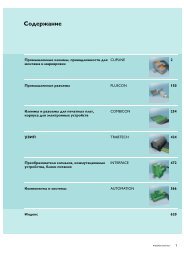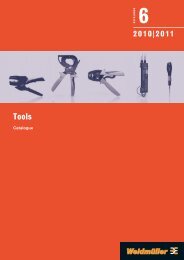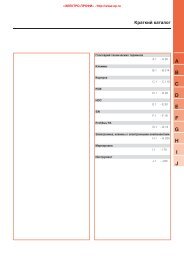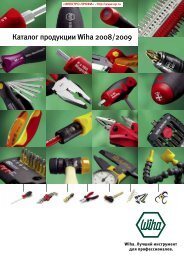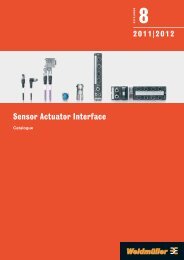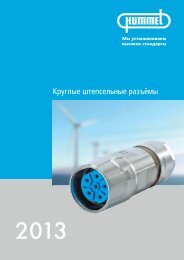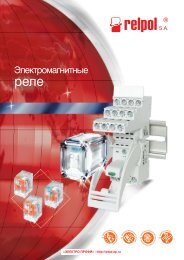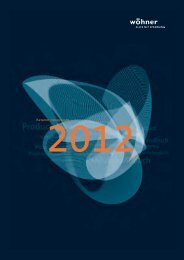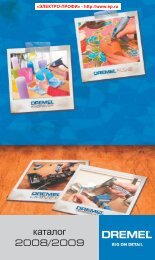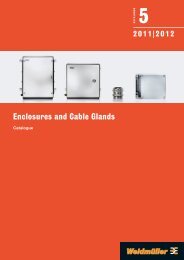ÐаÑалог Weidmuller: Electronics - Analogue Signal Conditioning
ÐаÑалог Weidmuller: Electronics - Analogue Signal Conditioning
ÐаÑалог Weidmuller: Electronics - Analogue Signal Conditioning
You also want an ePaper? Increase the reach of your titles
YUMPU automatically turns print PDFs into web optimized ePapers that Google loves.
Technical appendix/Glossary<br />
EX basics<br />
Safety in hazardous areas<br />
Which explosion protection categories are most commonly<br />
used<br />
These devices are divided into the category groups and<br />
which differ in the number of occurring malfunctions.<br />
W<br />
• Pressure-resistant encapsulation (Ex d) in compliance<br />
with EN60079-1:<br />
Components that are capable of triggering an explosion are<br />
enclosed in a housing that is capable of withstanding the<br />
explosion. Openings in the housing are designed to prevent<br />
the explosion from being transmitted externally.<br />
• Increased safety (Ex e) in compliance with EN60079-1:<br />
This explosion protection category is normally applied to<br />
transformers, motors, batteries, terminal blocks, electrical<br />
lines and cables. It is not suitable for the protection of electronic<br />
components and spark-generating components (such as<br />
switches, relays or surge protection). Additional measures<br />
and an increased safety level are implemented in order to<br />
prevent any sparks, electrical arcing or unallowable high<br />
temperatures which could trigger ignitions. Increased safety<br />
is made by possible by housing that prevents dusts from<br />
penetrating within.<br />
• Explosion protection methods (Ex n):<br />
This explosion protection category may only be used in the<br />
hazardous areas 2/22. Here there is no danger of an explosion<br />
from the electrical equipment during normal operations or<br />
during defined malfunctions. This includes all elec trical<br />
devices and components that have no spark-forming<br />
contacts and that have a water-proof or dust-proof housing.<br />
Larger creepage and clearance distances are not required<br />
as long as the maximum rated voltage of 60 V AC / 70 V DC<br />
is maintained.<br />
• Intrinsic safety (Ex i) in compliance with EN60079-11:<br />
Power supply to the electrical equipment is carried out<br />
through a safety barrier which functions to limit the current<br />
and voltage so that the minimum power and temperature<br />
levels for creating an explosive mixture are not reached.<br />
Intrinsic safety for electrical and electronic devices is specified<br />
so that their circulating or stored power (even in event of<br />
malfunction) is never strong enough to trigger an explosion<br />
in an explosive atmosphere. You must also remember that<br />
not only the electrical device but also all other components<br />
connected to the circuit may be exposed to the explosive<br />
atmosphere. All switching circuits in intrinsically safe devices<br />
must be designed so that they are also intrinsically safe.<br />
Category <br />
=> Switching circuits within category electrical devices<br />
must not be able to cause a spark even if two independent<br />
malfunctions take place.<br />
Category <br />
=> Switching circuits in electrical devices must not be able to<br />
cause a spark when a malfunction.<br />
Electrical devices for use in explosive gas, vapour and<br />
mist atmospheres – in accordance with CENELEC<br />
Explosion protection type Identification<br />
Pressure-resistant Ex d<br />
encapsulation<br />
Protective design<br />
Encloses the explosion and prevents fire<br />
from spreading<br />
Increased safety Ex e No spark formation or hot surfaces<br />
Method of explosion protection Ex n No spark formation or hot surfaces<br />
Intrinsic safety Ex i Limited energy for preventing spark formation<br />
or overheated surface temperatures<br />
CENELEC classification of gases, dusts and the<br />
maximum permitted surface temperatures of devices<br />
and components<br />
Gas<br />
Temperature classes<br />
group T1 T2 T3 T4 T5 T6<br />
I Methane - - - - -<br />
IIA Ammonia Ethyl alcohol Benzene, Acetaldehyde - -<br />
Methane<br />
Ethane<br />
Propane<br />
Cyclohexane<br />
n-Butane<br />
n-Hexane<br />
Kerosene<br />
IIB Lighting Ethylene, Ethylene Ethyl ether - -<br />
gases,<br />
Acrylonitrile<br />
Ethylene<br />
oxide<br />
glycol,<br />
Hydrogen<br />
sulphide<br />
IIC Hydrogen Ethine<br />
(Acetylene)<br />
- - - Hydrocarbons<br />
W.14



